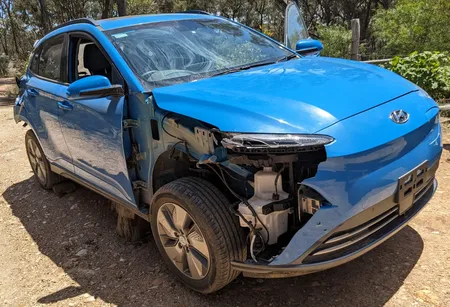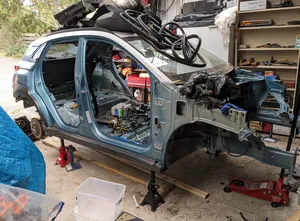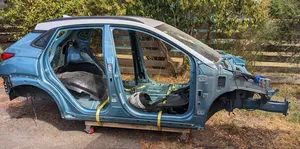This is part 5 of series "Kona EV Conversion":
- Salvaging a Kona
- Dismantling the Kona
- Kona CAN Decoding
- The motor turns (too much)
- Unremarkable Kona Progress (this post)
I've been holding off posting as I haven't had any major breakthroughs with the Kona Electric reversing project. However, I haven't sat totally idle...
On-car testing
Last post the Kona motor started to spin, but without a load attached it was spinning out of control! Even in Neutral, the motor ran away to high RPM...
First assumption was that this was partly my fault as I was faking some of the CAN messages, including wheel speeds. I imagined the Vehicle Control Unit (VCU) trying to stabilise a control loop with impossible and incorrect feedback inputs...
However, back in January my mate Oli and I fired up his crashed Kona, which is dented but still intact apart from the accident damage. We lifted the front wheels off the ground, and tested what happens when the motor turns unloaded:
(Note: The vehicle was better supported than it looks in this photo, and no one went near the underside or front of the Kona during tests.)
The behaviour is exactly the same!
With the wheels off the ground in Drive, even a short gentle press of the accelerator quickly spins the motor to high rpm. The controller then over-compensates by running the motor briefly in reverse, before accelerating forward again. The loop continues at progressively higher RPMs...
Here's a short video with some relevant CAN signals overlaid:
Note that the motor only stops oscillating when the brake is applied again (bottom graph).
Also, putting the Kona into Neutral with the wheels off the ground causes uncontrolled acceleration. The motor RPM is seen to steadily rise:
(These videos are screencasts of comma.ai's Cabana tool, playing files generated with my custom tool.)
As far as we know, and according to vehicle diagnostics, all of this car's drivetrain components are operating normally... Of course, with brakes still connected to the wheel hubs then it's a lot easier to stop a runaway motor by touching the brake pedal. Motor torque in these scenarios is minimal.
I'm a bit surprised Hyundai's engineers are OK with all of this behaviour. If a driveshaft or a CV joint breaks then it seems likely that the driveshaft on that side will spin up in the same way, and brakes won't be able to stop that! It's very unsettling, although in my experiments the motor controller (MCU) eventually tripped out due to a "Motor Excess Current" Fault which stops the motor. Perhaps this is the intended fail-safe behaviour that the engineers came up with.
Without any known way to stop a freewheeling motor, it seems like any EV conversion using the Kona VCU will have to essentially be direct drive - the same as the original Kona - without a clutch or a way to put any mechanical gearbox into Neutral.
Playing Hobby Wrecker
The other task consuming my time has been playing "hobby wrecker". Now I've got the parts I need from the crashed Kona, I need to do something with the rest:
If I lived closer to a major city then I might have found a wrecker who'd take the whole thing from me, but it's a bit harder out here.
Similarly, if I was more pragmatic then I might have just sold the whole thing for scrap metal, including all the doodads and modules and pieces of trim. I couldn't bring myself to waste this much.
So instead I've been painstakingly taking everything off the shell, so I can list it for sale. Most vehicle wreckers don't work like this - they keep the car whole and only take off parts as people request them. The way I'm doing it is an enormously inefficient use of time. It would only ever be a viable business if you knew in advance that all of the parts will be in high demand (which they are not!)
Nevertheless, I finally got the stripped down shell out of the shed. It's now off to be crushed and recycled:
As of last week the shed is tidied up and looks like a place that someone could work, again!
Solar Battery Storage
A semi-related bit of news that I wanted to shout out, the Finnish EV repairer and YouTuber Dala has an open source project to re-purpose various Electric Vehicle battery packs for solar storage, keeping the battery pack together and communicating between a high voltage solar inverter and the original Battery Management System.
Recently this project added support for Hyundai Kona batteries, and it's been interesting to see the community investigating CAN control of these.
I'm a little leery of some of the current technical choices, as I understand it the current "Battery Emulator" firmware for Kona is sending UDS diagnostic requests to close the Kona contactors. I'm not sure if this bypasses some of the normal BMS failsafe checks, and that doesn't seem ideal to me (although the inverter and the Emulator firmware both do their own checks, so it might be 100% fine.)
In any case, they're still working on improving it, and it's a commendable goal to work towards safe reuse of Electric Vehicle batteries as stationary storage. The alternative (much hyped by carmakers), is to send them directly into recycling channels - but this is a massively less efficient way to recover such highly engineered resources.
Dala's Discord, in particular, has been very interesting to hang out on. He hosts a very friendly community.
Next?
Now my shed is usable again, I'm looking forward to powering up the Bench Kona and continuing to test. Soon it'll be necessary to make a judgement call on whether the OEM VCU is suitable for an EV conversion, or whether it will be better to use something like an openinverter motor control board instead...



Thoughts on “Unremarkable Kona Progress”